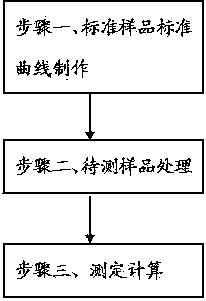Method for rapidly measuring arsenic element in grain by X fluorescent spectrometry
A fluorescence spectrometry and rapid determination technology, which is applied in the field of heavy metal determination in grains, can solve the problems that the detection accuracy and repeatability are inferior to the spectrometry method, the processing time is long, and the operation is cumbersome. Effect
- Summary
- Abstract
- Description
- Claims
- Application Information
AI Technical Summary
Problems solved by technology
Method used
Image
Examples
Embodiment Construction
[0032] The embodiments described below are exemplary, and are only for explaining the present invention, and should not be construed as limiting the present invention.
[0033] The X fluorescence spectrometry method of the present invention will be described below with reference to accompanying drawing to the rapid determination method of arsenic element in grain, wherein figure 1 is a flowchart of the present invention.
[0034] According to an embodiment of the present invention, such as figure 1 As shown, the X fluorescence spectrometry method provided by the present invention comprises:
[0035] Step 1. Preparation of standard sample standard curve: A series of arsenic grain powders with standard content gradients are passed through mesh sieves respectively, put into sample cups and compacted;
[0036] Scan a series of standard samples on the computer to obtain the X-ray fluorescence intensity of standard samples with known content, and calibrate the standard curve;
[...
PUM
 Login to View More
Login to View More Abstract
Description
Claims
Application Information
 Login to View More
Login to View More - R&D
- Intellectual Property
- Life Sciences
- Materials
- Tech Scout
- Unparalleled Data Quality
- Higher Quality Content
- 60% Fewer Hallucinations
Browse by: Latest US Patents, China's latest patents, Technical Efficacy Thesaurus, Application Domain, Technology Topic, Popular Technical Reports.
© 2025 PatSnap. All rights reserved.Legal|Privacy policy|Modern Slavery Act Transparency Statement|Sitemap|About US| Contact US: help@patsnap.com

